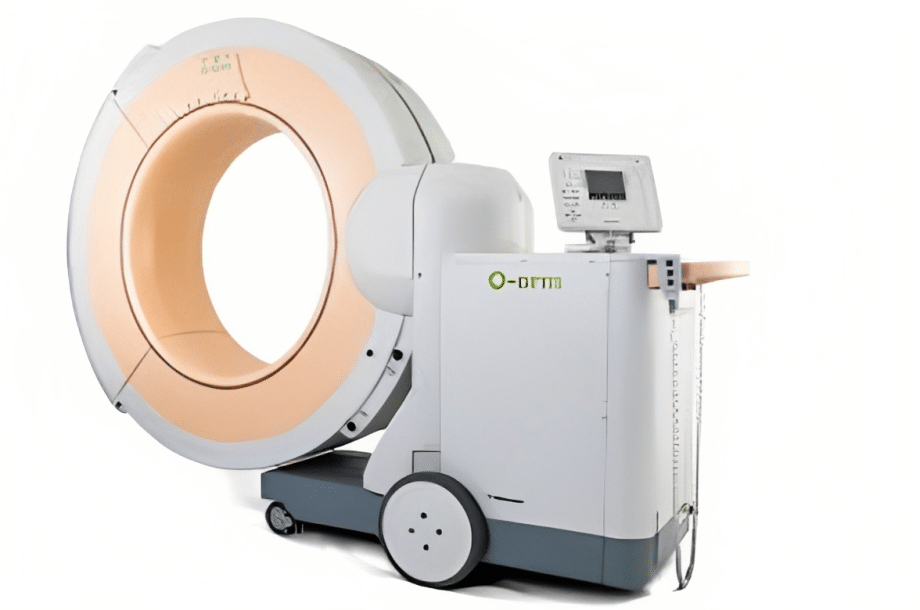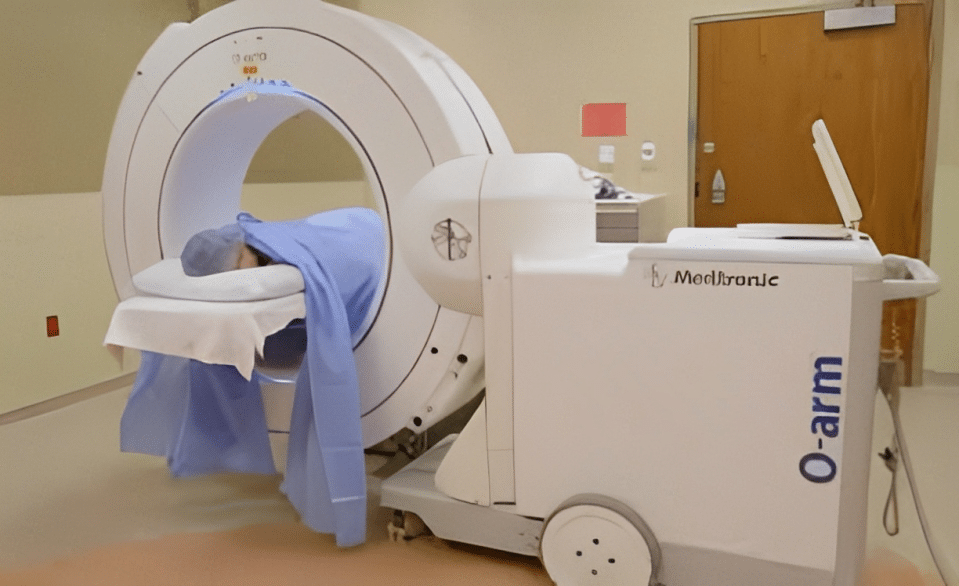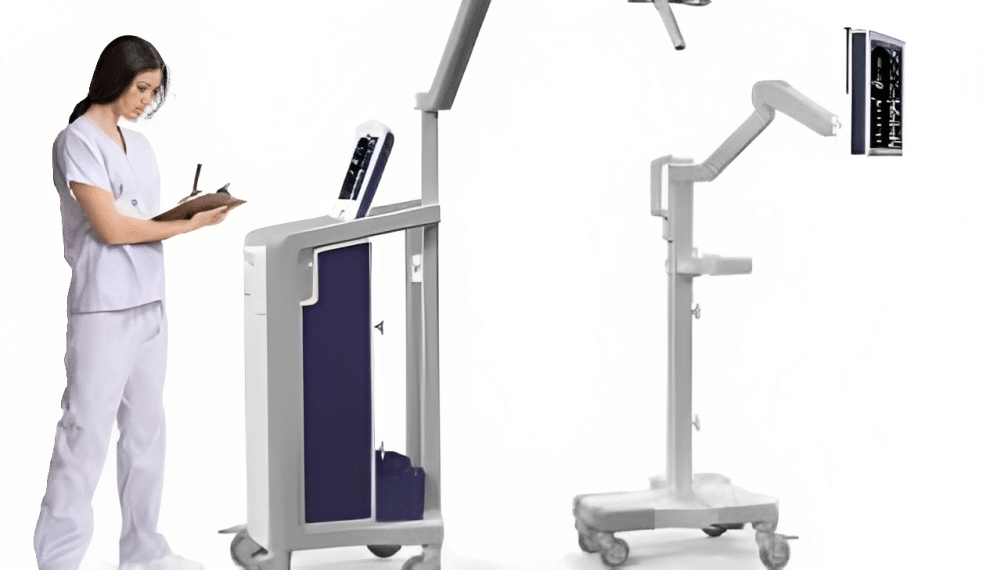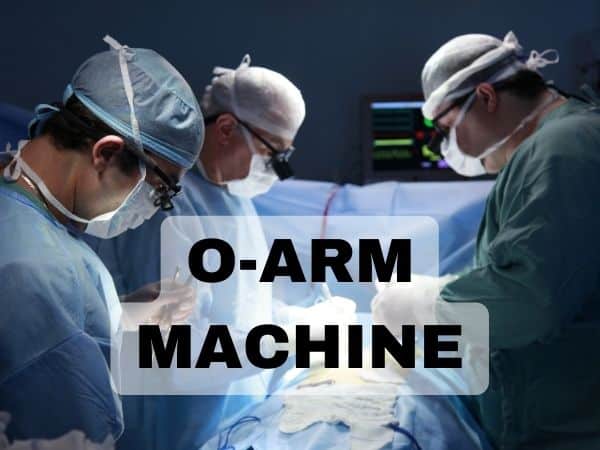O arm Machine

O-arm Machine is a medical imaging device that uses X-rays to produce real-time 2D and 3D images of the patient’s anatomy during surgery. It is designed to meet the workflow demands of the surgical environment and can be used in a variety of procedures including spine, cranial, and orthopedics.
O arm Machine is also known as O-arm Surgical Imaging System or O-arm O2 Imaging System. Medtronic, a global leader in medical technology, services, and solutions, manufactures it.
How Does O Arm Machine Work?

O-arm Machine consists of three main components: a gantry, a patient table, and a workstation.
- The gantry is a mobile X-ray system that has a C-shaped arm that can rotate around the patient to obtain different views and angles. The gantry has an X-ray source and a detector that can produce 2D fluoroscopic images or 3D volumetric images. The gantry can also be docked or undocked to allow easy access to the patient.
- The patient table is a surgical table that can be adjusted to different positions and heights. The patient table is compatible with certain image-guided surgery systems, such as StealthStation Navigation System, that can use the images from the O arm Machine to guide the surgical instruments.
- The workstation is a computer that controls the gantry and displays the images on a monitor. The workstation has software that allows the surgeon to adjust the image parameters, select the imaging protocols, and perform image processing and analysis.
What Are the Benefits of an O arm Machine?

O arm Machine has many benefits for both patients and surgeons. Some of the benefits are:
- Improved accuracy and safety: The O-arm Machine allows the surgeon to see the anatomy and pathology of the patient clearly and precisely. This helps to avoid damage to vital structures, reduce complications, and ensure proper placement of implants and instruments. Studies have shown that the O-arm Machine can improve the accuracy of pedicle screw placement in spine surgery, reduce the risk of revision surgery in cranial surgery, and enhance the outcomes of orthopedic trauma surgery.
- Reduced radiation exposure: The O-arm Machine uses lower doses of radiation than conventional X-ray machines. It also has features such as pulse fluoroscopy, collimation, and dose control that help to minimize radiation exposure to the patient, surgeon, and staff. Studies have shown that an O arm Machine can reduce radiation exposure by up to 87% compared to conventional fluoroscopy.
- Faster and easier procedures: O-arm Machine enables the surgeon to perform complex and minimally invasive procedures with less time and effort. It also reduces the need for multiple exposures or repositioning of the patient or the device. Studies have shown that an O arm Machine can reduce the operative time by up to 40% compared to conventional fluoroscopy.
- Better outcomes and recovery: O-arm machines can improve the quality and effectiveness of the surgery. It can reduce blood loss, infection, pain, scarring, and hospital stay. It can also enhance the functionality and durability of the implants and instruments. Studies have shown that an O arm Machine can improve clinical outcomes by up to 50% compared to conventional fluoroscopy.
What Are the Demerits of O arm Machine?
O arm Machine also has some demerits that need to be considered. Some of the demerits are:
- High cost: O arm Machine is an expensive device that requires maintenance and calibration. It also consumes a lot of electricity and space. The cost of an O arm Machine may vary depending on the type, size, features, and brand of the device. According to an online marketplace for business products and services in the USA, the approximate price range of O arm machines in the USA is about 60,900 to 121,800 USD.
- Limited field of view: The O arm Machine has a small detector area that limits the field of view. It may not be able to capture large or deep structures or organs. It may also have difficulty in imaging obese or metal-containing patients.
- Image quality: O arm Machine may not produce high-quality images as compared to other imaging modalities such as CT scan or MRI. It may have issues such as noise, distortion, artifacts, or blurring. It may also be affected by external factors such as temperature, humidity, or magnetic fields.
- Radiation risk: O arm Machine still involves exposure to ionizing radiation that can cause harm to the patient, surgeon, and staff. The risk depends on the exposure’s duration, frequency, intensity, and distance. The effects of radiation may include skin burns, cataracts, cancer, or genetic mutations.
Types of O Arm Machine

There are two types of O arm Machines:
- O-arm Surgical Imaging System: This is the original O-arm Machine that was launched in 2005. It is an intraoperative 2D/3D imaging system that can be used for spine, cranial, and orthopedic procedures. It has a 40 cm bore diameter and a 30 cm field of view. It is compatible with certain image-guided surgery systems, such as StealthStation Navigation System.
- O-arm O2 Imaging System: This is the latest O-arm Machine that was launched in 2018. It is an upgraded version of the O-arm Surgical Imaging System that has improved features and performance. It has a 50 cm bore diameter and a 40 cm field of view. It can produce higher-resolution images and faster scan times. It is also compatible with certain image-guided surgery systems, such as StealthStation Navigation System.
Differences Between O Arm Machine Vs C Arm Machine

| Criteria | O arm Machine | C-Arm machine |
|---|---|---|
| Size and shape | Circular, large, heavy | C-shaped, small, light |
| Features | 2D and 3D imaging, automatic registration, multiple imaging modes | 2D imaging, manual registration, fewer imaging modes |
| Applications | Spinal surgery, cranial surgery, orthopedic surgery | Orthopedics, vascular, urology, neurology, cardiology, pain management, extremity imaging |
| Cost | High purchase price and maintenance cost, high electricity consumption | Low purchase price and maintenance cost, low electricity consumption |
| Radiation exposure | High dose and low time | Low dose and high time |
Conclusion
O arm Machine is a sound medical imaging device that can provide real-time 2D and 3D images of the patient’s anatomy during surgery. It has many benefits such as improved accuracy, reduced radiation exposure, faster procedures, and better outcomes. However, it also has some demerits such as high cost, limited field of view, image quality issues, and radiation risk. Therefore, it is important to weigh the pros and cons of the O arm Machine before using it for any surgical procedure.
References
(1) O-arm – Surgical Imaging Systems | Medtronic.
(2) Medtronics O Arm Machine
(3) O-arm® Surgical 3D Imaging | Swift Institute.
